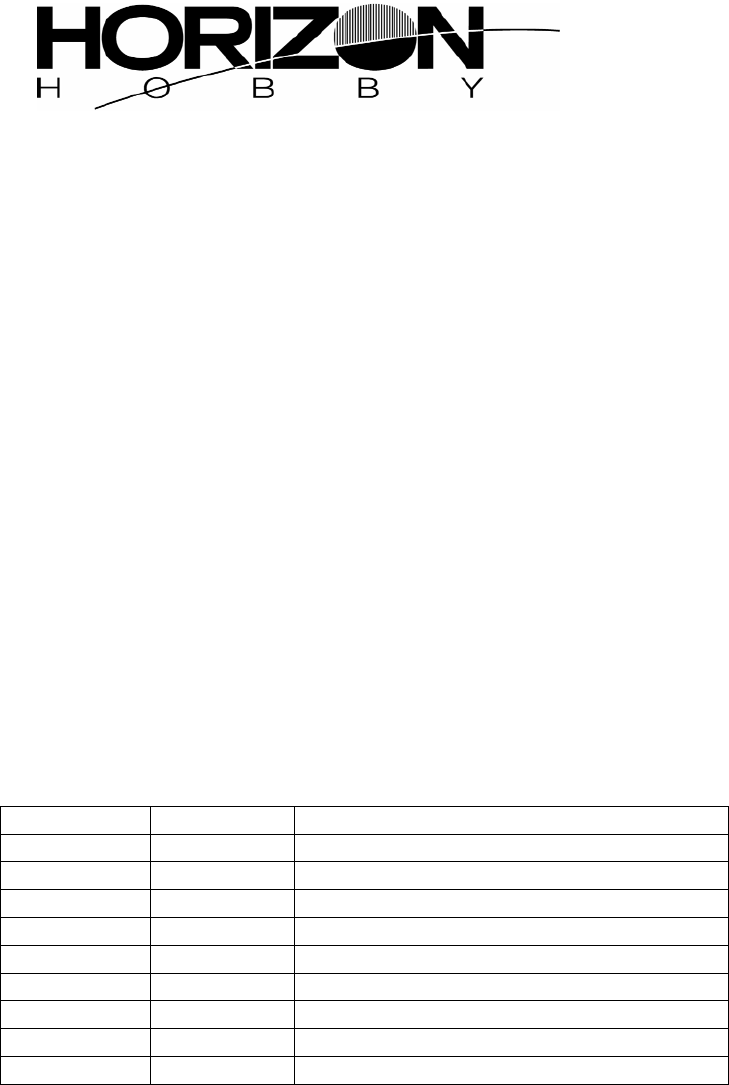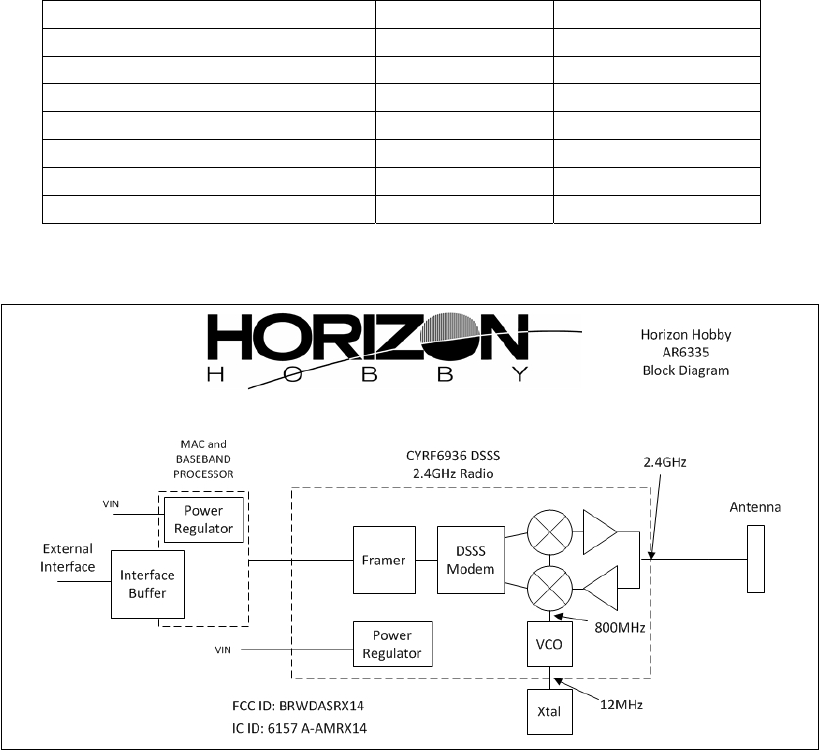Horizon Hobby DASRX14 Recevier User Manual AR6335 User Guidex
Horizon Hobby, LLC Recevier AR6335 User Guidex
User Manual

AR6335 2.4GHz DSMX Receiver User Manual.
Horizon Hobby Inc.,
4105 Fieldstone Rd
Champaign, IL 61822
(408) 203 4408
1. Features
2.4GHz Direct Sequence Spread Spectrum (DSSS) radio transceiver module.
Operates in the unlicensed worldwide ISM band (2.4 GHz to 2.483.5GHz) band
Fully integrated power regulation with a wide input unregulated operating range
3V to 12V.
Fully integrated local oscillator and 12MHz 20ppm reference crystal
50mA operating current
Transmit power 2.5mW EIRP
Receive sensitivity up to -95dBm
DSSS data rates up to 250kbps
1 mile operating range
Full packet assembling and disassembling
Auto transaction sequencer
Fully buffered digital interface with high voltage tolerant inputs
2. Pin description
Pin Number Name Description
J1-J7, Pin 1 VRAW DC Incoming Power
J1-J7, Pin 2 Ground Ground
J1-3 BIND Bind
J2-3 Channel 1 PWM Data for Channel 1
J3-3 Channel 2 PWM Data for Channel 2
J4-3 Channel 3 PWM Data for Channel 3
J5-3 Channel 4 PWM Data for Channel 4
J6-3 Channel 5 PWM Data for Channel 5
J7-3 Channel 6 PWM Data for Channel 6

3. Specifications
Parameter Value Units
Storage Temp -65 to 105 Degrees Celsius
VDD 3.0 to 12.0 Volts
Receive Sensitivity -95 dBm
Transmit power (radiated) 4 dBm MAX
Idle current 1 mA
Receive current 22 mA
Transmit current 50 mA
4. Block Diagram
5. FCC Statement:
This equipment has been tested and found to comply with the limits for Part 15 of the FCC rules. These limits are
designed to provide reasonable protection against harmful interference in a residential installation. Thisequipment
generates, uses and can radiate radio frequency energy and, if not installed and used in accordance with the
instructions, may cause harmful interference to radio communications.
However, there is no guarantee that interference will not occur in a particular installation. If this equipment does
cause harmful interference to radio or television reception, which can be determined by turning the equipment
off and on, the user is encouraged to try to correct the interference by one or more of the following measures:
• Reorient or relocate the receiving antenna.
• Increase the separation between the equipment and receiver.
• Connect the equipment to an outlet on a circuit different from that to which the receiver is connected.
This device complies with part 15 of the FCC rules. Operation is subject to the following two conditions: (1) This
device may not cause harmful interference, and (2) this device must accept any interference received, including
interference that may cause undesired operation.
Note: Modifications to this product will void the user’s authority to operate this equipment.
6. IC Statement:
This device complies with Industry Canada licence-exempt RSS standard(s). Operation is subject to the following
two conditions: (1) this device may not cause interference, and (2) this device must accept any interference,
including interference that may cause undesired operation of the device."
IC Déclaration:
Le présent appareil est conforme aux CNR d'Industrie Canada applicables aux appareils radio exempts de licence.
L'exploitation est autorisée aux deux conditions suivantes : (1) l'appareil ne doit pas produire de brouillage, et (2)
l'utilisateur de l'appareil doit accepter tout brouillage radioélectrique subi, même si le brouillage est susceptible
d'en compromettre le fonctionnement.
Remarque: Toute modification de ce produit annule l'autorité de l'utilisateur à utiliser cet équipement.